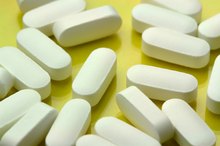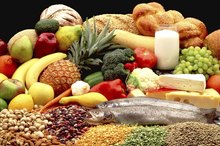What Are the Benefits of Forever Living Nature-Min?
In this era of fast foods you might not be getting all the minerals that your body requires. Nature-Min is a food supplement, offered by the company Forever Living, that provides a variety of nutrients including minerals that promote a healthy body.
Sea Minerals
The seabed is a rich source of minerals that have not been disturbed by pollution. Nature-Min taps this rich resource to procure high-quality minerals, according to Forever Living's website.
Bones and Teeth
What Is Tricalcium Phosphate?
Learn More
The Forever Living Website lists calcium, magnesium, and phosphorus among the ingredients of Nature-Min. These minerals are essential for healthy bones and teeth. If your diet is deficient in calcium, your body will remove calcium from your bones and apply it elsewhere. Osteoporosis may result.
- The Forever Living Website lists calcium, magnesium, and phosphorus among the ingredients of Nature-Min.
- These minerals are essential for healthy bones and teeth.
Cytosolic Calcium
Cytosolic calcium (calcium that floats around in the cytoplasm of. your cells) functions in muscle contraction, cell division, hormonal control, neural signaling, and egg fertilization. According to the Forever Living website, Nature-Min will give you enough calcium for all these functions.
- Cytosolic calcium (calcium that floats around in the cytoplasm of.
- your cells) functions in muscle contraction, cell division, hormonal control, neural signaling, and egg fertilization.
The pH Factor
Equate Multivitamin Ingredients
Learn More
According to the Forever Living website, Nature-Min contains phosphorus, potassium, and sodium, which regulate the pH of your blood. Sodium is not commonly deficient in your diet because of the ubiquity of table salt. By providing phosphorus and potassium Nature-Min promotes healthy blood chemistry.
Minerals Associated with Organic Molecules
Certain minerals are closely associated with physiologically significant organic molecules. Zinc, iron, copper, manganese, molybdenum, and selenium are cofactors that attach themselves to some of your enzymes and enable them to function. Iodine, phosphorus, and iron are integral components of thyroid hormones, nucleic acids, and hemoglobin, respectively. Nature-Min offers both the cofactors and these three components of organic molecules in its formula.
- Certain minerals are closely associated with physiologically significant organic molecules.
- Zinc, iron, copper, manganese, molybdenum, and selenium are cofactors that attach themselves to some of your enzymes and enable them to function.
Easy Absorption by the Body
The website of Nature-Min assures us that their minerals are chelated, and therefore easily absorbed by your body. Nature-Min also contains croscarmellose sodium, which absorbs a lot of water, thus dissolving Nature-Min’s other minerals and making it easier for your body to use them.
Related Articles
References
- Biology, Fifth Edition, Neil A. Campbell, Jane B. Reece, Lawrence G. Mitchell, 1999, pp. 198, 199, 200, 903, 904, 971, 796, 1017, 1018









